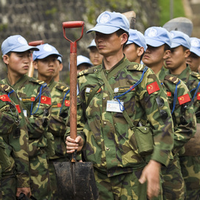It is now widely recognized -- including in the highest-level policy statements of the United Nations, European Union, African Union and NATO -- that managing conflict requires a multidimensional, comprehensive, whole-of-government or integrated approach. All these approaches have a similar aim: to achieve greater harmonization and synchronization among the international and local actors, as well as across the analysis, planning, implementation and evaluation phases of the program cycle. One-dimensional or single-facet conflict-management responses are now viewed as superficial and counterproductive, in that they address only some aspects of a wider system. They thus tend to distort, shift or redirect tensions in the system, rather than dealing with the root causes of the conflict in a coherent or comprehensive manner.
At the national level, several governments have been experimenting with improving the coherence among their own ministries or departments, with a view to improving the overall effectiveness of their international operations. These initiatives are now referred to as the "whole-of-government" approach. The Canadian government may not have been the first to develop such an approach, but it coined the "3D" concept -- diplomacy, development and defense -- which has so succinctly captured the essence of the whole-of-government framework.
The African Union, the European Union, the North Atlantic Treaty Organization and the United Nations have also each developed their own specific approaches aimed at fostering greater coherence. The EU and NATO have both adopted the "comprehensive approach" concept to describe their respective initiatives to pursue coherence, while the African Union and the United Nations have both opted for the "integrated approach." The terms all convey the understanding that operations must be coordinated among the various actors involved. However, as we shall see, each of these four organizations has a slightly different understanding of what this means in practice.

